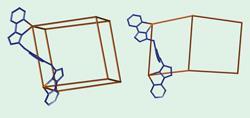Two different molecular cages, made from the same metal salt and bridging ligand, could aid the development of controlled self-assembly.
Two different molecular cages, made from the same metal salt and bridging ligand, could aid the development of controlled self-assembly.
Self-assembly of simple building-blocks into complex, highly symmetrical structures is commonly found in nature for example in virus formation. Self-assembly of a metal salt and ligand can occur by different pathways, leading to a mixture of two distinct architectures.
Michael Ward at the University of Sheffield, UK, and colleagues at the University of Huddersfield, UK, have shown how two different structures, one resembling a cube and one an open book, can be made from the same basic chemical components.

Eight metal ions and 12 bridging ligands made a cubic cage, a structure cable of acting as a molecular container into which other small molecules can be placed. The same six metal ions and nine ligands also made an open book structure.
There is ’an almost magical fascination in seeing these structures appear without any major effort,’ said Ward. He also said that the complexity of these structures is surprising because he would expect much simpler architecture to be formed instead.
Understanding the reasons for this might allow researchers to regain control of the structures produced by self-assembly. A longer-term challenge will be to use computational techniques to predict the outcome of these self-assembly processes, he said.
Suzanne J Abbott
References
S P Argent, H Adams, L P Harding and M D Ward, Dalton Trans., 2006 (DOI: 10.1039/<MAN>b515296h</MAN>)






No comments yet